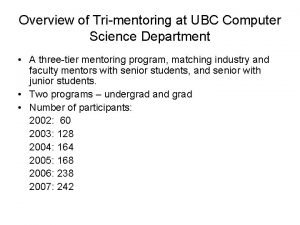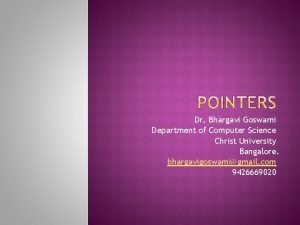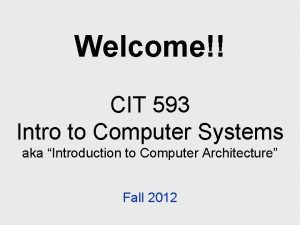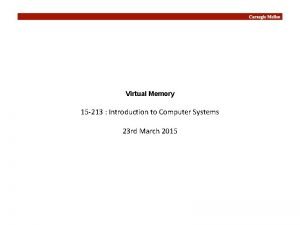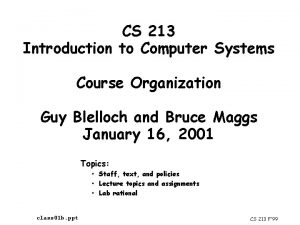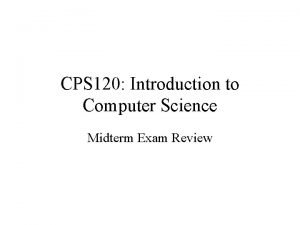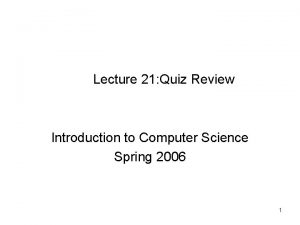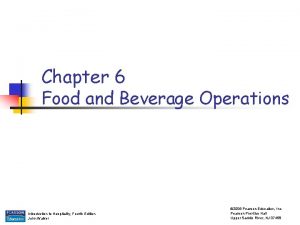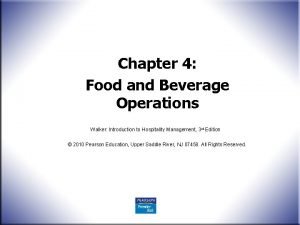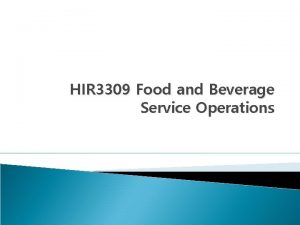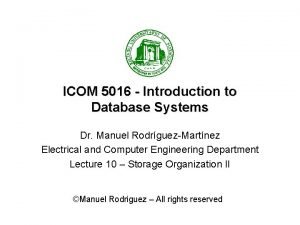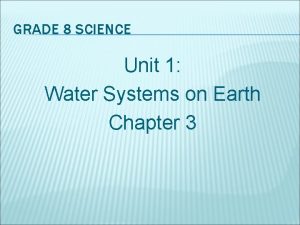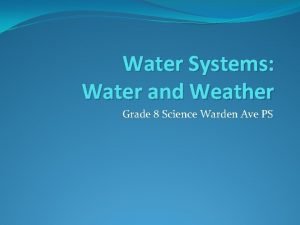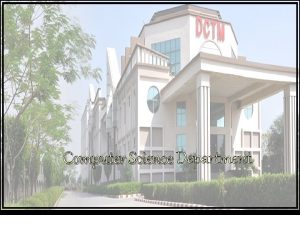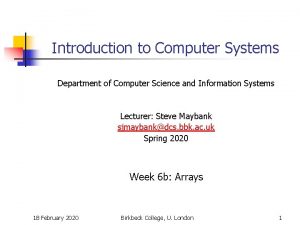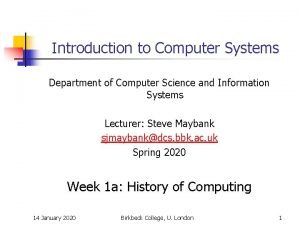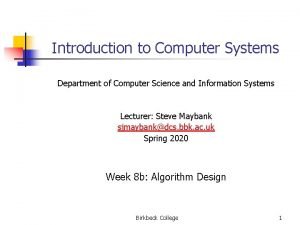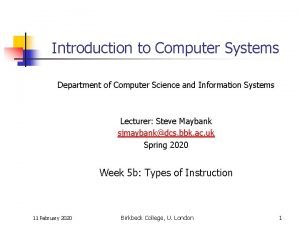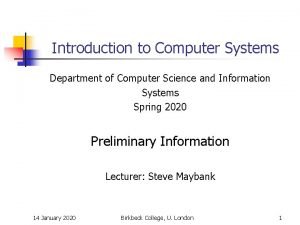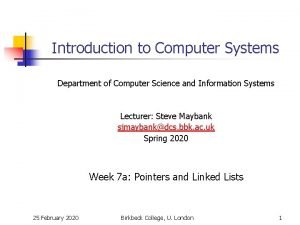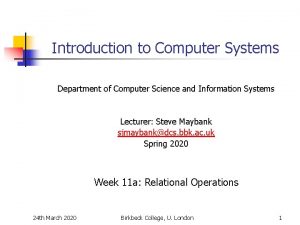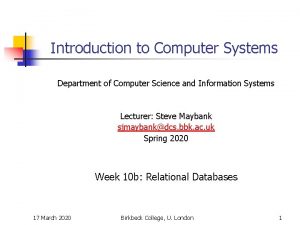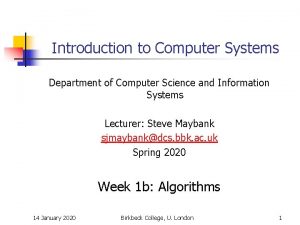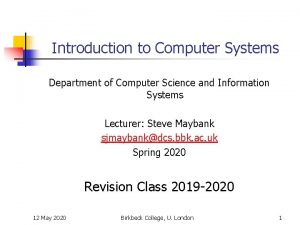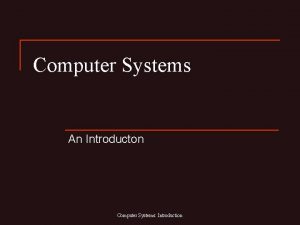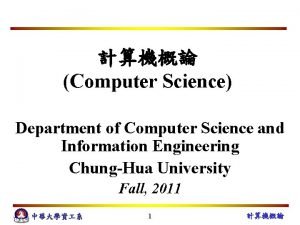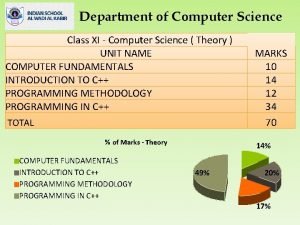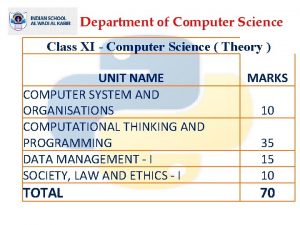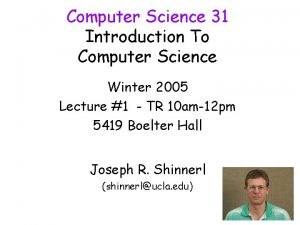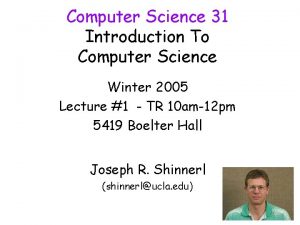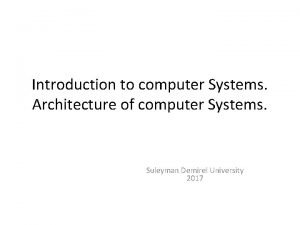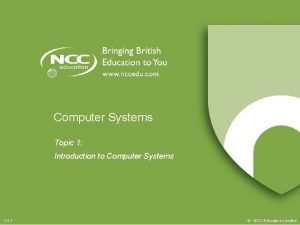Introduction to Computer Systems Department of Computer Science































- Slides: 31

Introduction to Computer Systems Department of Computer Science and Information Systems Lecturer: Steve Maybank sjmaybank@dcs. bbk. ac. uk Spring 2020 Revision of the Summer 2017 Examination Birkbeck College, U. London 1

Question 1 a § Add the decimal integers 15 and 27 § Show your working + Answer: 2 7 1, carry 5 4 2 Birkbeck College, U. London 2

Question 1 b § Subtract the binary number 101 from § the binary number 11001. Show your working. 1 Answer: 1 1 borrow, 0 0 1 repay 1 0 1 0 0 Birkbeck College, U. London 3

Question 1 c n Birkbeck College, U. London 4

Question 1 d n Birkbeck College, U. London 5

Question 2 a n Which of the following are Boolean statements? n (3+7)*2 (3+7) == 2 C=4 6 < 10 n Answer: those that have a value True or False n n n Birkbeck College, U. London 6

Question 2 b n Write out the truth table for A OR B. A B A OR B 0 0 0 1 0 1 1 1 § Truth tables for NOT A, A AND B, A XOR B? Birkbeck College, U. London 7

Question 2 c n n Write out a Boolean expression that is true if x is strictly less than y or strictly greater than y+5 x < y OR x > y+5 Birkbeck College, U. London 8

Question 3 a n Birkbeck College, U. London 9

Question 3 b Birkbeck College, U. London 10

Question 4 a n Explain the terms track and sector for a hard drive n Why do the tracks have their shape? Birkbeck College, U. London 11

Question 4 b n n n A hard drive has a capacity of 4 TB. The data rate for reading is 100 MB per s. How many seconds are required for reading the whole disk? 0. 1 GB per s 1 GB in 10 s 1 TB = 1000 GB 4 TB = 4000 GB read in 4000*10 = 40000 s Birkbeck College, U. London 12

Question 5 a n n Give an example of a two-dimensional array of integers. Answer: a 3 x 3 array: 4 1 0 0 4 0 2 3 2 Birkbeck College, U. London 13

Question 5 b n n How is it possible to store a 2 dimensional array in a one dimensional memory? Answer: one row at a time: 4 4 1 0 0 4 0 2 3 2 1 0 0 4 0 2 Birkbeck College, U. London 3 2 14

Question 5 c n n Write a pseudo code algorithm to add the numbers in a one dimensional array A and print the result. Other tasks: max, min, find i such that A[i] < A[i+1] Birkbeck College, U. London 15

Question 5 c Continued n n n n sum = 0 i=0 while i < length(A) sum = sum+A[i] i = i+1 end. While print(sum) Birkbeck College, U. London 16

Question 6 a n Explain the action of the instruction with op code 8 Answer: 8 RST, bitwise And the contents of registers S and T. Put the result in register R. E. g. S 0 1 1 0 0 1 1 1 T 0 0 1 1 1 0 R 0 0 1 1 0 Birkbeck College, U. London 17

Question 6 b n n Write a program to load the contents of memory cell 91 into a register, set the rightmost 4 bits to 0 and store the resulting bit string in cell 92. Answer: 1191 Load register 1 with the bit pattern in cell 91 22 F 0 Load register 2 with F 0 = 11110000 8312 And registers 1 and 2, put result in register 3 3392 Store the register 3 bit pattern in cell 92 Birkbeck College, U. London 18

Question 7 a n n n Define the term algorithm. Why are algorithms important? Answer (bookwork): an ordered set of unambiguous executable steps that defines a terminating process. An algorithm is required for any task to be performed by a computer. Birkbeck College, U. London 19

Question 7 b § Why is there no algorithm for printing all the integers less than 5? § Answer: the process requires an infinite number of steps Birkbeck College, U. London 20

Question 7 c § Implement a loop in a program. Write out a pseudo code example. § Answer: in a while loop a Boolean expression is evaluated. If the expression is true, then a block of code is executed and the expression is evaluated again. If false, then the code following the while loop is executed Birkbeck College, U. London 21

Question 7 c (Example) § Pseudo code example of a while loop § i=0 § while i < 5 § print(i) § i = i+1 § end. While Birkbeck College, U. London 22

Question 8 a § Describe one advantage and one disadvantage of a linked list. § Answer (bookwork): the different items in the list can be stored anywhere in memory § To access an element it is necessary to search the list item by item Birkbeck College, U. London 23

Question 8 b § Describe the way in which the head pointer and the null pointer are used. § Answer (bookwork): the value of the head pointer is the location of the first element on the list. § The null pointer marks the end of the list. Birkbeck College, U. London 24

Question 8 c § Replace the item B in the list with the item D addresses contents 10 11 12 13 14 15 16 17 18 19 H 12 A 16 C 0 B 14 D 0 initial H 12 A 16 B 14 C 0 updated H 12 A 18 D 14 C 0 Birkbeck College, U. London 25

Question 9 a § Why is a sequential file appropriate for storing music? § Answer: when the music is played the records in the file are accessed in the same order that they are stored in the file. This makes access efficient. Birkbeck College, U. London 26

Question 9 b § Describe the structure of an index file. § Answer (bookwork): The data in the file is stored in a list of records. Each record is identified by a unique key. The file contains an index which consists of pairs (k, a) where k is the key of a record and a is the address of the location where the record is stored. Birkbeck College, U. London 27

Question 9 c n Birkbeck College, U. London 28

Question 10 a function gcd(m, n) while (m ≠ n) r = m-n m = maximum(n, r) n = minimum(n, r) end. While return m end. Function § What happens if gcd is called with m > 0 and n = 0 ? Birkbeck College, U. London 29

Question 10 a (Continued) function gcd 1(m, n) if n == 0, return m end. If while (m ≠ n) r = m-n m = maximum(n, r) n = minimum(n, r) end. While return m end. Function § Write out a new function gcd 1 that returns the GCD if m ≥n > 0 and returns m if m > n = 0. Birkbeck College, U. London 30

Question 10 b function gcd 2(m 1, n 1) if m 1 ≥ n 1 return gcd(m 1, n 1) else return gcd(n 1, m 1) end. If end. Function § Write out a new function gcd 2 that returns the GCD if m ≥ n > 0 or if n > m > 0. Birkbeck College, U. London 31
 Ucl computer science department
Ucl computer science department Electrical engineering northwestern
Electrical engineering northwestern Computer science department rutgers
Computer science department rutgers Stanford computer science department
Stanford computer science department Florida state university masters in computer science
Florida state university masters in computer science Ubc computer science department
Ubc computer science department Department of computer science christ
Department of computer science christ Columbia university department of computer science
Columbia university department of computer science My favourite subject is pe
My favourite subject is pe Science fusion digital lessons
Science fusion digital lessons Cit 593
Cit 593 15-213 introduction to computer systems
15-213 introduction to computer systems 15-213 introduction to computer systems
15-213 introduction to computer systems Introduction to computer science midterm exam
Introduction to computer science midterm exam Introduction to computer science midterm exam test
Introduction to computer science midterm exam test C++ code
C++ code Python programming an introduction to computer science
Python programming an introduction to computer science Department of forensic science dc
Department of forensic science dc Oh.nesinc
Oh.nesinc Iit delhi material science
Iit delhi material science Introduction to food and beverage service department
Introduction to food and beverage service department Introduction to food and beverage service department
Introduction to food and beverage service department Introduction to food and beverage service
Introduction to food and beverage service Introduction to food and beverage service department
Introduction to food and beverage service department Tum
Tum Computer engineering department
Computer engineering department Decision support systems and intelligent systems
Decision support systems and intelligent systems Principles of complex systems for systems engineering
Principles of complex systems for systems engineering Embedded systems vs cyber physical systems
Embedded systems vs cyber physical systems Engineering elegant systems: theory of systems engineering
Engineering elegant systems: theory of systems engineering Mrs bader grade 8 science
Mrs bader grade 8 science Grade 8 science water systems
Grade 8 science water systems





